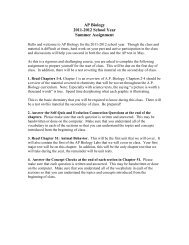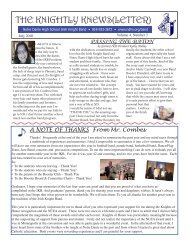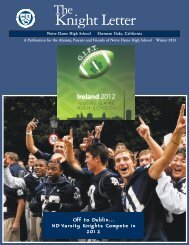You also want an ePaper? Increase the reach of your titles
YUMPU automatically turns print PDFs into web optimized ePapers that Google loves.
2/6/13 Issues and Controversies <strong>in</strong> American History - <strong>Flappers</strong><br />
→ More Facts On File Databases<br />
Hello ! | REGISTER / LOGIN<br />
Subject Index Era Index Search<br />
Advanced Search<br />
Filed Under: Society and Social Issues • Women and Gender • 1900-1928: Progressivism and <strong>the</strong> Emergence of Modern America<br />
<strong>Flappers</strong><br />
Frivolous Time-Wasters, or America's New Liberated Women?<br />
Full Article<br />
The Issue<br />
Background<br />
Case For<br />
Case Aga<strong>in</strong>st<br />
Conclusion<br />
Bibliography<br />
The Issue<br />
Pr<strong>in</strong>t<br />
Email<br />
Save To Folder<br />
Citation<br />
Increase Text<br />
Decrease Text<br />
Timel<strong>in</strong>e<br />
Read Aloud<br />
Primary Sources<br />
Learn More About<br />
Dancers—Library of Congress. Pr<strong>in</strong>ts and Photographs Division; Woman pos<strong>in</strong>g—Denver Public<br />
Library/Library of Congress<br />
The issue: In <strong>the</strong> ealy 20th century, a new breed of young woman<br />
emerged; <strong>the</strong> so-called flapper was op<strong>in</strong>ionated, smoked and drank<br />
heavily, and flaunted her sexuality <strong>in</strong> ways considered shock<strong>in</strong>g at <strong>the</strong><br />
time. Are flappers selfish, time-wast<strong>in</strong>g young women who are erod<strong>in</strong>g<br />
<strong>the</strong> moral fabric of <strong>the</strong> country? Or are <strong>the</strong>y <strong>in</strong>telligent, free-spirited<br />
women who boldly assert <strong>the</strong>ir <strong>in</strong>dependence from outdated moral<br />
standards and gender roles?<br />
Arguments aga<strong>in</strong>st <strong>the</strong> flapper culture: <strong>Flappers</strong> are a<br />
disgrace to society because <strong>the</strong>y are lazy pleasure-seekers who<br />
are only <strong>in</strong>terested <strong>in</strong> dr<strong>in</strong>k<strong>in</strong>g, party<strong>in</strong>g, and flirt<strong>in</strong>g. They often<br />
neglect <strong>the</strong>ir education and refuse to make important<br />
commitments such as marriage and child-rear<strong>in</strong>g. <strong>Flappers</strong> also<br />
spend far too much money on clo<strong>the</strong>s to achieve a trendy look,<br />
and, despite claim<strong>in</strong>g to be <strong>in</strong>dependent, are <strong>in</strong> fact conformists<br />
who adhere to common fashion styles and behavior modes<br />
dictated by o<strong>the</strong>rs. Ultimately, flappers give fem<strong>in</strong>ists a bad name<br />
by over<strong>in</strong>dulg<strong>in</strong>g <strong>in</strong> <strong>the</strong>ir newfound social freedoms and imitat<strong>in</strong>g<br />
<strong>the</strong> worst and most excessive habits of men.<br />
Arguments <strong>in</strong> favor of <strong>the</strong> flapper culture: <strong>Flappers</strong> are<br />
<strong>in</strong>telligent, self-willed young women who have earned <strong>the</strong> right to<br />
pursue a passionate lifestyle. In some respects, <strong>the</strong>y are a new<br />
k<strong>in</strong>d of fem<strong>in</strong>ist, s<strong>in</strong>ce <strong>the</strong>y aggressively assert <strong>the</strong>ir social,<br />
professional, and sexual <strong>in</strong>dependence from men. Their<br />
behavior, far from be<strong>in</strong>g destructive, will help to establish full<br />
equality between <strong>the</strong> sexes. Fur<strong>the</strong>rmore, critics are wrong to<br />
assert that flappers are fundamentally immoral when compared<br />
with <strong>the</strong>ir elders; many flappers behave responsibly <strong>in</strong> <strong>the</strong>ir<br />
icah.<strong>in</strong>fobaselearn<strong>in</strong>g.com/icahfullarticle.aspx?ID=107556 1/11
2/6/13 Issues and Controversies <strong>in</strong> American History - <strong>Flappers</strong><br />
pursuit of self-fulfillment, and <strong>the</strong>ir free-spirited behavior is really<br />
not unlike <strong>the</strong> youthful exuberance of previous generations.<br />
Background<br />
The "flapper" was an exotic new breed of young woman who dom<strong>in</strong>ated <strong>the</strong><br />
cosmopolitan scene of <strong>the</strong> late 1910s and, especially, <strong>the</strong> 1920s. The stereotypical<br />
flapper was a slender, fashionable, op<strong>in</strong>ionated woman who partied hard, smoked and<br />
drank heavily, and flaunted her sexuality <strong>in</strong> ways considered shock<strong>in</strong>g at <strong>the</strong> time. The<br />
bold and often wild behavior of flappers made <strong>the</strong>m a lightn<strong>in</strong>g rod for controversy.<br />
<strong>Flappers</strong> <strong>in</strong>itially flourished <strong>in</strong> <strong>the</strong> United States after World War I (1914-18), which<br />
triggered various political and cultural changes. For example, <strong>the</strong> conflict's brutality<br />
left many young people disillusioned and led <strong>the</strong>m to question traditional morality and<br />
values. The war also <strong>in</strong>directly accelerated <strong>the</strong> development of women's rights; for <strong>the</strong><br />
duration of <strong>the</strong> fight<strong>in</strong>g, many women took jobs that had been left vacant by men who<br />
went off to fight <strong>in</strong> <strong>the</strong> war, and <strong>the</strong>y became more confident <strong>in</strong> <strong>the</strong>ir ability to work and<br />
function <strong>in</strong>dependently of men.<br />
Women's rights enjoyed a fur<strong>the</strong>r boost from <strong>the</strong> ratification of <strong>the</strong> N<strong>in</strong>eteenth<br />
Amendment to <strong>the</strong> Constitution <strong>in</strong> 1920, which granted women <strong>the</strong> power to vote. The<br />
fem<strong>in</strong>ist movement was runn<strong>in</strong>g strong at <strong>the</strong> time, and it encouraged women to<br />
aggressively pursue <strong>the</strong>ir goals and become more active <strong>in</strong> politics and society. The<br />
flapper emerged amid that climate of social change, and came to symbolize a new<br />
form of liberated woman. [See Woman Suffrage]<br />
The development of <strong>the</strong> flapper was also l<strong>in</strong>ked to radical new trends <strong>in</strong> fashion,<br />
music, and male-female courtship rituals. <strong>Flappers</strong> typically abandoned traditional<br />
garments such as long dresses and corsets, <strong>in</strong>stead wear<strong>in</strong>g skimpier clo<strong>the</strong>s that<br />
were, by Victorian-era standards, scandalously provocative. They also became<br />
notorious for danc<strong>in</strong>g wildly—often to jazz music—and allow<strong>in</strong>g <strong>the</strong>mselves to be<br />
kissed or "petted" (fondled) by a series of disposable male suitors. They often<br />
avoided long-term commitments such as marriage and child-rear<strong>in</strong>g, preferr<strong>in</strong>g to live<br />
and work as <strong>the</strong>y pleased.<br />
Although <strong>the</strong> controversy over flappers and <strong>the</strong>ir behavior might seem qua<strong>in</strong>t by<br />
modern standards, at <strong>the</strong> time it was considered a serious topic for debate. In April<br />
1922, <strong>the</strong> New York Times ran an article by Margaret O'Leary, "More Ado about <strong>the</strong><br />
Flapper," which effectively summed up <strong>the</strong> contemporary dispute on <strong>the</strong> matter.<br />
"Concern—and consternation—about <strong>the</strong> flapper are general," O'Leary declared.<br />
"Roughly, <strong>the</strong> world is divided <strong>in</strong>to those who delight <strong>in</strong> her, those who fear her and<br />
those who try pa<strong>the</strong>tically to take her as a matter of course. Optimists have called her<br />
<strong>the</strong> hope of <strong>the</strong> new era, pessimists po<strong>in</strong>t to her as ultimate evidence of <strong>the</strong><br />
decadence of <strong>the</strong> old."<br />
As O'Leary <strong>in</strong>dicated, flapper culture polarized observers. Many people ma<strong>in</strong>ta<strong>in</strong>ed<br />
that flappers were irresponsible and self-destructive, while o<strong>the</strong>rs <strong>in</strong>sisted that <strong>the</strong>y<br />
were an excit<strong>in</strong>g new breed of <strong>in</strong>dependent woman. The debate grew steadily until it<br />
<strong>in</strong>volved <strong>the</strong> press, famous writers and artists, and even politicians who could not<br />
resist comment<strong>in</strong>g on <strong>the</strong> flapper phenomenon.<br />
Critics of flappers argued that <strong>the</strong>y were lazy, self-absorbed young women who<br />
contributed little or noth<strong>in</strong>g to <strong>the</strong> general welfare of society. <strong>Flappers</strong> tended to<br />
neglect <strong>the</strong>ir education <strong>in</strong> <strong>the</strong> pursuit of pleasure, <strong>the</strong>ir detractors charged, and<br />
consequently were often un<strong>in</strong>formed and un<strong>in</strong>volved. <strong>Flappers</strong> also avoided important<br />
responsibilities such as marriage and child-rear<strong>in</strong>g, critics compla<strong>in</strong>ed, and <strong>the</strong>reby<br />
underm<strong>in</strong>ed <strong>the</strong> traditional family's central position <strong>in</strong> society.<br />
O<strong>the</strong>r detractors of flappers ma<strong>in</strong>ta<strong>in</strong>ed that <strong>the</strong>y were essentially conformists, not<br />
free spirits, because <strong>the</strong>y adhered to popular trends <strong>in</strong> fashion and behavior. In <strong>the</strong>ir<br />
icah.<strong>in</strong>fobaselearn<strong>in</strong>g.com/icahfullarticle.aspx?ID=107556 2/11
2/6/13 Issues and Controversies <strong>in</strong> American History - <strong>Flappers</strong><br />
view, <strong>the</strong>n, flappers were not really bold <strong>in</strong>dividuals but just thoughtless consumers of<br />
trendy clo<strong>the</strong>s and cosmetics. Some accused flappers of harm<strong>in</strong>g <strong>the</strong> fem<strong>in</strong>ist cause<br />
by over<strong>in</strong>dulg<strong>in</strong>g <strong>in</strong> alcohol, smok<strong>in</strong>g, and sex—<strong>the</strong>se excessive habits that<br />
underm<strong>in</strong>ed <strong>the</strong> progress of women by mak<strong>in</strong>g <strong>the</strong>m appear irresponsible and out of<br />
control.<br />
Defenders of flappers, on <strong>the</strong> o<strong>the</strong>r hand, characterized <strong>the</strong>m as strong-willed and<br />
<strong>in</strong>dependent women who were worthy of admiration. In <strong>the</strong>ir view, flappers had every<br />
right to dr<strong>in</strong>k, party, and flirt with various partners. After all, <strong>the</strong>y argued, males had<br />
enjoyed such social privileges for generations, and it seemed only fair that <strong>the</strong><br />
liberated "new woman" should now enjoy <strong>the</strong>m too.<br />
Supporters of <strong>the</strong> flapper culture also disputed critics' claims that flappers were<br />
empty-headed and neglectful of <strong>the</strong>ir education. They ma<strong>in</strong>ta<strong>in</strong>ed that <strong>the</strong> genu<strong>in</strong>e<br />
flapper was <strong>in</strong>telligent and well-read, and felt free to express her views on traditionally<br />
male-dom<strong>in</strong>ated topics such as politics and art. Advocates also challenged claims that<br />
all flappers lived wild lifestyles and were antifamily, argu<strong>in</strong>g that many flappers<br />
behaved responsibly and would make perfectly good wives and mo<strong>the</strong>rs if <strong>the</strong>y<br />
decided to settle down.<br />
Genesis of <strong>the</strong> Flapper<br />
No s<strong>in</strong>gle event created <strong>the</strong> flapper, but historians have p<strong>in</strong>po<strong>in</strong>ted a number of<br />
factors that led to her <strong>in</strong>itial appearance. World War I was one of <strong>the</strong> most important<br />
catalysts. The conflict left 116,000 Americans dead and more than 200,000 wounded,<br />
and it caused many young people to question traditional morality and <strong>the</strong> judgment of<br />
those among <strong>the</strong>ir elders who had supported <strong>the</strong> fight<strong>in</strong>g.<br />
In 1922, self-confessed flapper Ellen Welles Page succ<strong>in</strong>ctly described <strong>the</strong> effects of<br />
World War I on her generation. "The war tore away our spiritual foundations and<br />
challenged our faith," she wrote. "We are struggl<strong>in</strong>g to rega<strong>in</strong> our equilibrium." To put<br />
it ano<strong>the</strong>r way, <strong>the</strong> war shocked many young people <strong>in</strong>to los<strong>in</strong>g <strong>the</strong>ir faith <strong>in</strong><br />
established <strong>in</strong>stitutions such as religion and <strong>the</strong> family, and some of <strong>the</strong>m embraced<br />
<strong>the</strong> flapper's wild lifestyle as an expression of <strong>the</strong>ir newfound cynicism. [See "A<br />
Flapper's Appeal to Parents" (primary document)]<br />
The war also had <strong>the</strong> effect of push<strong>in</strong>g women fur<strong>the</strong>r <strong>in</strong>to <strong>the</strong> workforce, as <strong>the</strong>y took<br />
a variety of jobs that had been left vacant by male soldiers. (Women also regularly<br />
found new jobs as operators <strong>in</strong> <strong>the</strong> <strong>the</strong>n-boom<strong>in</strong>g telephone <strong>in</strong>dustry.) By 1929, more<br />
than 50 percent of s<strong>in</strong>gle women <strong>in</strong> <strong>the</strong> United States were employed, and many of<br />
<strong>the</strong>m lived alone and supported <strong>the</strong>mselves <strong>in</strong> large cities such as Chicago and New<br />
York City.<br />
Historians note that 1920s work<strong>in</strong>g women typically struggled to make ends meet, and<br />
earned less than men. Never<strong>the</strong>less, hav<strong>in</strong>g a job enabled some of <strong>the</strong>m to ma<strong>in</strong>ta<strong>in</strong><br />
<strong>the</strong> flapper's often-extravagant lifestyle. Also, whereas women had frequently been<br />
isolated from one ano<strong>the</strong>r <strong>in</strong> past generations, dur<strong>in</strong>g <strong>the</strong> 1920s <strong>the</strong>y often worked<br />
toge<strong>the</strong>r <strong>in</strong> large groups; this <strong>in</strong>creased <strong>in</strong>teraction helped to speed <strong>the</strong> development<br />
of all-female subcultures like <strong>the</strong> flappers.<br />
Various o<strong>the</strong>r social changes accelerated <strong>the</strong> birth of <strong>the</strong> flapper, <strong>in</strong>clud<strong>in</strong>g changes <strong>in</strong><br />
th<strong>in</strong>k<strong>in</strong>g about dat<strong>in</strong>g, sex, and marriage. Prior to World War I, American women had<br />
typically been required to behave <strong>in</strong> a passive manner while dat<strong>in</strong>g, and avoid any<br />
sexually aggressive behavior. In his book Only Yesterday: An Informal History of <strong>the</strong><br />
1920s (1931), historian Frederick Lewis Allen asserted that prewar women were<br />
"guardians of morality" who were expected to "look forward <strong>in</strong> <strong>in</strong>nocence...to a<br />
romantic love match which would lead <strong>the</strong>m to <strong>the</strong> altar and to liv<strong>in</strong>g happily-everafter;<br />
and until <strong>the</strong> 'right man' came along <strong>the</strong>y must allow no male to kiss <strong>the</strong>m."<br />
Around <strong>the</strong> time of <strong>the</strong> war, conservative attitudes toward dat<strong>in</strong>g, sex, and gender<br />
roles began to erode. For <strong>in</strong>stance, accord<strong>in</strong>g to sociological surveys, only 14 percent<br />
of American women had premarital sex prior to 1900, but that percentage rose to 39<br />
icah.<strong>in</strong>fobaselearn<strong>in</strong>g.com/icahfullarticle.aspx?ID=107556 3/11
2/6/13 Issues and Controversies <strong>in</strong> American History - <strong>Flappers</strong><br />
percent dur<strong>in</strong>g <strong>the</strong> 1910s and 1920s. Fur<strong>the</strong>rmore, <strong>the</strong> <strong>in</strong>stitution of marriage started<br />
to lose its status as a sacred and unbreakable bond around that time; <strong>the</strong> reported<br />
number of divorces doubled from about 100,000 <strong>in</strong> 1914 to 205,000 <strong>in</strong> 1929.<br />
These changes <strong>in</strong> <strong>the</strong> sexual and social climate suited flappers, who tended to avoid<br />
long-term commitments such as marriage and enjoyed flirt<strong>in</strong>g with multiple male<br />
partners. Most flappers claimed that <strong>the</strong>re was noth<strong>in</strong>g particularly outrageous about<br />
<strong>the</strong>ir behavior, s<strong>in</strong>ce sexual aggressiveness <strong>in</strong> young men had been widely tolerated<br />
for some time. In <strong>the</strong>ir view, <strong>the</strong>y were simply work<strong>in</strong>g to elim<strong>in</strong>ate <strong>the</strong> social "double<br />
standard" that had hi<strong>the</strong>rto enabled men, but not women, to engage <strong>in</strong> premarital<br />
flirtations and sexual activity.<br />
In addition to chang<strong>in</strong>g social attitudes, technological developments also played a part<br />
<strong>in</strong> <strong>the</strong> sexual revolution of <strong>the</strong> flappers. For example, <strong>the</strong> proliferation of <strong>the</strong><br />
automobile dur<strong>in</strong>g <strong>the</strong> 1910s and 1920s allowed young men and women to go on<br />
drives away from <strong>the</strong>ir homes and enjoy dates <strong>in</strong> more private, romantic sett<strong>in</strong>gs.<br />
Fur<strong>the</strong>rmore, <strong>the</strong> <strong>in</strong>creased use of electric light<strong>in</strong>g fostered <strong>the</strong> development of an<br />
urban "night life," which enabled young people to stay out and party toge<strong>the</strong>r for<br />
longer periods of time. Without <strong>the</strong> advent of <strong>the</strong> automobile and <strong>the</strong> electric light,<br />
flappers might never have achieved <strong>the</strong> freedom necessary to develop <strong>the</strong>ir unique<br />
lifestyle.<br />
Ano<strong>the</strong>r important factor <strong>in</strong> <strong>the</strong> flapper's emergence was Prohibition (1920-33), a<br />
relatively short-lived attempt by <strong>the</strong> U.S. government to ban <strong>the</strong> manufacture, sale,<br />
and consumption of alcoholic beverages. Prohibition was unpopular <strong>in</strong> certa<strong>in</strong> social<br />
circles, and its opponents soon found illegal ways to obta<strong>in</strong> alcohol. Rebellious<br />
flappers particularly enjoyed flout<strong>in</strong>g Prohibition by party<strong>in</strong>g <strong>in</strong> underground dr<strong>in</strong>k<strong>in</strong>g<br />
establishments called speakeasies and carry<strong>in</strong>g hidden flasks of alcohol. (Their<br />
stereotypical dr<strong>in</strong>k of choice was g<strong>in</strong>.) Although Prohibition did suppress dr<strong>in</strong>k<strong>in</strong>g<br />
somewhat, it also gave <strong>the</strong> activity a glamorous and dangerous aura that appealed to<br />
flappers, and created an underground dr<strong>in</strong>k<strong>in</strong>g culture where <strong>the</strong>y could thrive. [See<br />
Prohibition]<br />
Fur<strong>the</strong>rmore, <strong>the</strong> growth of flapper culture was encouraged by jazz, a dynamic musical<br />
art form pioneered by African Americans dur<strong>in</strong>g <strong>the</strong> late 19th and early 20th centuries.<br />
Jazz was commonly associated with danc<strong>in</strong>g, and its widespread popularity contributed<br />
to an explosion of nightlife and dance clubs. Many flappers were attracted to jazz, both<br />
because <strong>the</strong>y appreciated <strong>the</strong> music on its own terms and because it was closely<br />
l<strong>in</strong>ked with excit<strong>in</strong>g social activities. Some conservative critics actually blamed jazz for<br />
<strong>in</strong>spir<strong>in</strong>g immoral behavior <strong>in</strong> flappers and o<strong>the</strong>r young people. Commentator Anne<br />
Shaw Faulkner, writ<strong>in</strong>g for <strong>the</strong> Ladies' Home Journal <strong>in</strong> 1921, branded <strong>the</strong> musical<br />
form an "evil <strong>in</strong>fluence" that stimulated base impulses such as "brutality and<br />
sensuality." [See "Does Jazz Put <strong>the</strong> S<strong>in</strong> <strong>in</strong> Syncopation?" (primary document)]<br />
In short, flappers were not created by any s<strong>in</strong>gle event, but by a series of political and<br />
social changes. The rise of women's rights, <strong>the</strong> decl<strong>in</strong>e of conservative morality, and<br />
<strong>the</strong> explosion of urban culture and nightlife comb<strong>in</strong>ed to produce <strong>the</strong> colorful and<br />
unprecedented figure of <strong>the</strong> flapper.<br />
Def<strong>in</strong><strong>in</strong>g <strong>the</strong> Flapper<br />
Although flappers arguably achieved <strong>the</strong>ir greatest notoriety <strong>in</strong> <strong>the</strong> United States, <strong>the</strong><br />
actual word "flapper" is believed to have orig<strong>in</strong>ated <strong>in</strong> England before World War I,<br />
and entered American usage around 1915. Some historians say that <strong>the</strong> term <strong>in</strong>itially<br />
referred to sk<strong>in</strong>ny young women who wore long, straight dresses (known as "flapperdresses")<br />
to conceal <strong>the</strong>ir lack of fem<strong>in</strong><strong>in</strong>e curves; o<strong>the</strong>rs ma<strong>in</strong>ta<strong>in</strong> that <strong>the</strong> word was<br />
used <strong>in</strong> a more pejorative sense, to refer to English prostitutes.<br />
In any event, commentators <strong>in</strong> <strong>the</strong> United States soon picked up <strong>the</strong> term, and began<br />
apply<strong>in</strong>g it to a controversial new type of young woman. Writer H. L. Mencken crafted<br />
a very early def<strong>in</strong>ition of <strong>the</strong> model flapper <strong>in</strong> 1915, describ<strong>in</strong>g her as someone<br />
"impossible to shock" and who was "opposed to <strong>the</strong> double standard of morality" that<br />
icah.<strong>in</strong>fobaselearn<strong>in</strong>g.com/icahfullarticle.aspx?ID=107556 4/11
2/6/13 Issues and Controversies <strong>in</strong> American History - <strong>Flappers</strong><br />
gave men more social freedom than women. He also enumerated <strong>the</strong> model flapper's<br />
physical characteristics, not<strong>in</strong>g that her skirts were short enough to reveal her ankles,<br />
and her hair was short enough to expose "<strong>the</strong> ravish<strong>in</strong>g whiteness of her neck." The<br />
short haircut Mencken referred to was known as "bobbed" hair, and quickly became<br />
one of <strong>the</strong> most recognizable physical characteristics of flappers. [See Flapper<br />
Fashions (sidebar)]<br />
O<strong>the</strong>r observers wrote <strong>the</strong>ir own elaborate def<strong>in</strong>itions <strong>in</strong> later years. In 1922, admitted<br />
ex-flapper Ruth Hooper pa<strong>in</strong>ted a strong, unapologetic portrait of flappers for <strong>the</strong> New<br />
York Times, writ<strong>in</strong>g: [See "Flapp<strong>in</strong>g Not Repented of" (Excerpt) (primary document)]<br />
A flapper is proud of her nerve—she is not even afraid of call<strong>in</strong>g it by its<br />
right name. She is shameless, selfish and honest, but at <strong>the</strong> same time<br />
she considers <strong>the</strong>se three attributes virtues. Why not? She takes a man's<br />
po<strong>in</strong>t of view as her mo<strong>the</strong>r never could, and when she loses she is not<br />
afraid to admit defeat, whe<strong>the</strong>r it be a prime lover or $20 at auction. She<br />
can take a man—<strong>the</strong> man of <strong>the</strong> hour—at his face value...with no foolish<br />
promises that will need a disturb<strong>in</strong>g and disagreeable break<strong>in</strong>g.<br />
Hooper's def<strong>in</strong>ition <strong>in</strong>cluded many of <strong>the</strong> classic elements of <strong>the</strong> flapper, <strong>in</strong>clud<strong>in</strong>g her<br />
assertiveness <strong>in</strong> tak<strong>in</strong>g a "man's po<strong>in</strong>t of view" (presumably on important issues of <strong>the</strong><br />
day) and her will<strong>in</strong>gness to experiment with various male suitors without mak<strong>in</strong>g<br />
commitments. Hooper suggested that those traits were strengths, but more<br />
conservative observers characterized <strong>the</strong>m as unladylike excesses.<br />
In 1925, New Republic editor Bruce Bliven offered yet ano<strong>the</strong>r def<strong>in</strong>ition <strong>in</strong> his profile<br />
of "Jane," an archetypal flapper who may or may not have existed. Adopt<strong>in</strong>g a clearly<br />
tongue-<strong>in</strong>-cheek style, Bliven described Jane as follows:<br />
She is, for one th<strong>in</strong>g, a very pretty girl. Beauty is <strong>the</strong> fashion <strong>in</strong> 1925. She<br />
is frankly, heavily made up, not to imitate nature, but for an altoge<strong>the</strong>r<br />
artificial effect—pallor mortis, poisonously scarlet lips, richly r<strong>in</strong>ged eyes<br />
—<strong>the</strong> latter look<strong>in</strong>g not so much debauched (which is <strong>the</strong> <strong>in</strong>tention) as<br />
diabetic. Her walk duplicates <strong>the</strong> swagger supposed by <strong>in</strong>nocent America<br />
to go with <strong>the</strong> female half of a Paris Apache dance. And <strong>the</strong>re are, f<strong>in</strong>ally,<br />
her clo<strong>the</strong>s. These were estimated <strong>the</strong> o<strong>the</strong>r day by some statistician to<br />
weigh two pounds. Probably a libel; I doubt <strong>the</strong>y come with<strong>in</strong> half a pound<br />
of such bulk. Jane isn't wear<strong>in</strong>g much, this summer.<br />
Taken toge<strong>the</strong>r, <strong>the</strong>se def<strong>in</strong>itions create a fairly complete portrait of <strong>the</strong> flapper, as<br />
she existed <strong>in</strong> <strong>the</strong> popular consciousness—if not always <strong>in</strong> reality. Accord<strong>in</strong>g to <strong>the</strong><br />
press, <strong>the</strong> flapper had a series of easily recognizable characteristics: she was<br />
flirtatious, op<strong>in</strong>ionated, short-haired, scantily clad (by 1920s standards), and generally<br />
outrageous. These characteristics were often enumerated <strong>in</strong> articles, works of fiction,<br />
poems, and even songs on <strong>the</strong> subject of <strong>the</strong> flapper. [See 'The Playful Flapper'<br />
(primary document)]<br />
While some writers concentrated simply on def<strong>in</strong><strong>in</strong>g flappers, o<strong>the</strong>rs actively<br />
popularized <strong>the</strong>ir lifestyle and culture. Foremost among <strong>the</strong>m was F. Scott Fitzgerald,<br />
whose timely short stories and novels often featured free-spirited, witty, amorous<br />
female characters who fit <strong>the</strong> public perception of flappers. Shortly after Fitzgerald<br />
ga<strong>in</strong>ed notoriety with <strong>the</strong> 1920 publication of his first novel, This Side of Paradise,<br />
journalists started bill<strong>in</strong>g him as <strong>the</strong> spokesman for his generation and its<br />
controversial culture; he was variously described <strong>in</strong> <strong>the</strong> press as <strong>the</strong> orig<strong>in</strong>ator of <strong>the</strong><br />
flapper, <strong>the</strong> country's foremost "expert on flappers," and even "Flapperdom's Fiction<br />
Ace." [See Bernice Bobs Her Hair (primary document)]<br />
Some of Fitzgerald's notable female characters were apparently <strong>in</strong>spired by his wife,<br />
Zelda Sayre Fitzgerald. In <strong>the</strong> eyes of many observers, she was <strong>the</strong> qu<strong>in</strong>tessential<br />
flapper due to her reputation for speak<strong>in</strong>g her m<strong>in</strong>d, dr<strong>in</strong>k<strong>in</strong>g heavily, and party<strong>in</strong>g<br />
relentlessly, often <strong>in</strong> <strong>the</strong> company of her husband. She also contributed to <strong>the</strong><br />
evolv<strong>in</strong>g def<strong>in</strong>ition of <strong>the</strong> model flapper, remark<strong>in</strong>g <strong>in</strong> 1922 that she was a woman who<br />
icah.<strong>in</strong>fobaselearn<strong>in</strong>g.com/icahfullarticle.aspx?ID=107556 5/11
2/6/13 Issues and Controversies <strong>in</strong> American History - <strong>Flappers</strong><br />
"flirted because it was fun to flirt" and "refused to be bored chiefly because she wasn't<br />
bor<strong>in</strong>g."<br />
O<strong>the</strong>r prom<strong>in</strong>ent contributors to <strong>the</strong> flapper culture <strong>in</strong>cluded Gabrielle (Coco) Chanel,<br />
a French cloth<strong>in</strong>g designer who <strong>in</strong> large part def<strong>in</strong>ed 1920s fashion, and New Yorker<br />
columnist Lois Long, a popular chronicler of big-city life. The flapper image was also<br />
shaped by a bevy of silent film actresses, <strong>in</strong>clud<strong>in</strong>g Clara Bow, Louise Brooks, Colleen<br />
Moore, and Constance Talmadge. Though movies of <strong>the</strong> 1920s were perhaps too<br />
tame to duplicate flapper culture exactly, <strong>the</strong>y did give many Americans a rough idea<br />
of what <strong>the</strong> culture was like. [See <strong>Flappers</strong> <strong>in</strong> Film (sidebar)]<br />
Re<strong>in</strong>forced by <strong>the</strong> press, fashion trends, and <strong>the</strong> movies, <strong>the</strong> image of <strong>the</strong> flapper<br />
became <strong>in</strong>creas<strong>in</strong>gly prevalent dur<strong>in</strong>g <strong>the</strong> early-to-mid 1920s. And, as <strong>the</strong> popularity<br />
of flappers grew, <strong>the</strong> debate over <strong>the</strong>ir impact on society grew as well. Over time, a<br />
slew of observers rang<strong>in</strong>g from concerned parents to religious figures to government<br />
officials expressed op<strong>in</strong>ions on <strong>the</strong> flapper phenomenon. Some saw <strong>the</strong> flapper as a<br />
harmless manifestation of youthful exuberance, while o<strong>the</strong>rs championed her as a<br />
liberated and excit<strong>in</strong>g "new woman." There were also those who saw <strong>the</strong> flapper as an<br />
outright threat to conventional morality, and hoped to see her exotic culture die out<br />
before it could become a permanent fixture of ma<strong>in</strong>stream consciousness.<br />
The Case for <strong>Flappers</strong><br />
<strong>Flappers</strong> were smart, liberated young women who had a legitimate right to embrace<br />
<strong>the</strong>ir unique and passionate lifestyle, advocates of <strong>the</strong> flapper culture ma<strong>in</strong>ta<strong>in</strong>ed.<br />
Journalist Dorothy Dunbar Bromley, writ<strong>in</strong>g for Harper's magaz<strong>in</strong>e <strong>in</strong> 1927, re<strong>in</strong>forced<br />
this positive view of <strong>the</strong> flapper as an admirable and <strong>in</strong>dependent figure; she<br />
described <strong>the</strong> typical young woman of <strong>the</strong> 1920s as someone who "knows that it is her<br />
American, her twentieth-century birthright to emerge from a creature of <strong>in</strong>st<strong>in</strong>ct to a<br />
fully fledged <strong>in</strong>dividual who is capable of mold<strong>in</strong>g her own life. And <strong>in</strong> this respect she<br />
holds that she is becom<strong>in</strong>g man's equal."<br />
Several o<strong>the</strong>r commentators made similar arguments that flappers were, <strong>in</strong> essence,<br />
fem<strong>in</strong>ists—albeit unusual ones. Accord<strong>in</strong>g to advocates of <strong>the</strong> flapper culture,<br />
American women of previous generations had been both sexually and <strong>in</strong>tellectually<br />
repressed, but flappers were freer to express <strong>the</strong>ir sexuality and <strong>the</strong>ir educated views<br />
on topics such as art, society, and politics. That new freedom of expression was, <strong>in</strong><br />
<strong>the</strong>ir view, a good th<strong>in</strong>g.<br />
New Republic editor Bruce Bliven made an explicit connection between flappers and<br />
fem<strong>in</strong>ism <strong>in</strong> a 1925 article, "Flapper Jane." "Women to-day are shak<strong>in</strong>g off <strong>the</strong> shreds<br />
and patches of <strong>the</strong>ir age-old servitude," he wrote <strong>in</strong> his profile of "Jane," <strong>the</strong><br />
archetypal flapper. Bliven fur<strong>the</strong>r suggested that certa<strong>in</strong> controversial traits of<br />
flappers, such as <strong>the</strong>ir sexual aggressiveness and aversion to traditional gender<br />
roles, could be seen as forms of fem<strong>in</strong>ist expression:<br />
Women have highly resolved that <strong>the</strong>y are just as good as men, and<br />
<strong>in</strong>tend to be treated so. They don't mean to have any more unwanted<br />
children. They don't <strong>in</strong>tend to be debarred from any profession or<br />
occupation which <strong>the</strong>y choose to enter. They clearly mean (even though<br />
not all of <strong>the</strong>m yet realize it) that <strong>in</strong> <strong>the</strong> great game of sexual selection<br />
<strong>the</strong>y shall no longer be forced to play <strong>the</strong> role, simulated or real, of<br />
helpless quarry. If <strong>the</strong>y want to wear <strong>the</strong>ir heads shaven, as a symbol of<br />
defiance aga<strong>in</strong>st <strong>the</strong> former fate which for three millennia forced <strong>the</strong>m to<br />
dress <strong>the</strong>ir heavy locks accord<strong>in</strong>g to male decrees, <strong>the</strong>y will have <strong>the</strong>ir<br />
way.<br />
Bliven's comments touched on a core argument <strong>in</strong> favor of flapper culture—that<br />
women were entitled to full equality with men <strong>in</strong> all spheres of society, rang<strong>in</strong>g from <strong>the</strong><br />
workplace to <strong>the</strong> home to <strong>the</strong> dance floor. Advocates of flapper culture were<br />
particularly aggressive <strong>in</strong> attack<strong>in</strong>g what <strong>the</strong>y perceived as society's double<br />
standards; <strong>the</strong>y argued that flappers had a perfect right to be sexually assertive<br />
icah.<strong>in</strong>fobaselearn<strong>in</strong>g.com/icahfullarticle.aspx?ID=107556 6/11
2/6/13 Issues and Controversies <strong>in</strong> American History - <strong>Flappers</strong><br />
before marriage, s<strong>in</strong>ce such behavior was already widely tolerated among men.<br />
Advocates also praised flappers for possess<strong>in</strong>g, and assert<strong>in</strong>g, unusual <strong>in</strong>telligence.<br />
In her July 1922 article for <strong>the</strong> New York Times, admitted "ex-flapper" Ruth Hooper<br />
described <strong>the</strong> typical flapper as eloquent and well-read: "She may even quote poetry<br />
to you, not Indian love lyrics, but someth<strong>in</strong>g about <strong>the</strong> peace conference [at<br />
Versailles, France, after World War I] or <strong>the</strong>ology. After all, she checks up pretty<br />
squarely, doesn't she?" In <strong>the</strong> view of Hooper and like-m<strong>in</strong>ded commentators, flappers<br />
deserved credit for assert<strong>in</strong>g <strong>the</strong> right of women to be conspicuously <strong>in</strong>telligent and<br />
for <strong>in</strong>sist<strong>in</strong>g on tak<strong>in</strong>g part <strong>in</strong> discussions of issues perta<strong>in</strong><strong>in</strong>g to formerly maledom<strong>in</strong>ated<br />
spheres such as academia, politics, and <strong>the</strong> arts.<br />
Hooper also contradicted critics' claims that flappers were antifamily. She predicted<br />
that <strong>the</strong> average flapper, thanks to her <strong>in</strong>telligence, honesty, and <strong>in</strong>dependence,<br />
would become an excellent mo<strong>the</strong>r once she matured and lost her youthful edge.<br />
"Watch her five years from now and <strong>the</strong>n be thankful that she will be <strong>the</strong> mo<strong>the</strong>r of <strong>the</strong><br />
next generation, with <strong>the</strong> hypocrisy, fluff and o<strong>the</strong>r 'hokum' worn entirely off," Hooper<br />
wrote. "Her sharp po<strong>in</strong>ts wear down remarkably well and leave a smooth polished<br />
surface. You'll be surprised at what a comfort that surface will be <strong>in</strong> <strong>the</strong> days to come!"<br />
Ellen Welles Page, ano<strong>the</strong>r self-proclaimed flapper, also defended <strong>the</strong> morality of her<br />
culture. In "A Flapper's Appeal to Parents," published <strong>in</strong> Outlook <strong>in</strong> December 1922,<br />
she argued that not all flappers lived a wild and irresponsible lifestyle. "I don't use<br />
rouge, or lipstick, or pluck my eyebrows," she wrote. "I don't smoke (I've tried it, and<br />
don't like it), or dr<strong>in</strong>k, or tell 'peppy stories.' I don't pet." But Page also asserted that<br />
she attended co-educational dances and sport<strong>in</strong>g events, which she ma<strong>in</strong>ta<strong>in</strong>ed were<br />
harmless and fun activities enjoyed by flappers, and did not necessarily lead to<br />
immoral behavior.<br />
Page fur<strong>the</strong>r suggested that members of <strong>the</strong> older generation were be<strong>in</strong>g hypocritical<br />
<strong>in</strong> <strong>the</strong>ir criticism of flappers. In a direct address to her adult readers, she wrote, "Th<strong>in</strong>k<br />
back to <strong>the</strong> time when you were struggl<strong>in</strong>g through <strong>the</strong> teens. Remember how<br />
spontaneous and deep were <strong>the</strong> joys, how serious and penetrat<strong>in</strong>g <strong>the</strong> sorrows." She<br />
was, <strong>in</strong> effect, encourag<strong>in</strong>g her older readers to see a l<strong>in</strong>k between <strong>the</strong>ir own carefree<br />
youths and <strong>the</strong> flapper culture. In <strong>the</strong> view of Page and o<strong>the</strong>r flapper apologists,<br />
youthful exuberance was a common phenomenon that recurred <strong>in</strong> each generation;<br />
so why, <strong>the</strong>y asked, should flappers be s<strong>in</strong>gled out for criticism by elders who had also<br />
behaved passionately when <strong>the</strong>y were young?<br />
Not only young people and radicals defended flappers. Many older people and<br />
"establishment" figures <strong>in</strong> <strong>the</strong> political and religious communities also spoke <strong>in</strong> favor of<br />
<strong>the</strong> flapper culture. For <strong>in</strong>stance, <strong>in</strong> May 1922, Reverend Almer Pennewell of<br />
Evanston, Ill<strong>in</strong>ois, gave a sermon defend<strong>in</strong>g flappers. "Flapperism is not a disease,"<br />
he asserted. "Bobbed hair, short skirts and knickerbockers are not signs of s<strong>in</strong>, but a<br />
declaration of <strong>in</strong>dependence."<br />
Pennewell, like o<strong>the</strong>r advocates of flapper culture, explicitly l<strong>in</strong>ked <strong>the</strong> flapper to <strong>the</strong><br />
rise of fem<strong>in</strong>ism. "We are pass<strong>in</strong>g from <strong>the</strong> man age, a rough age, <strong>in</strong>to <strong>the</strong> age of<br />
culture, <strong>the</strong> women's age. That is why <strong>the</strong> flapper exists today," he said. "The new age<br />
will not be one ruled by women, but one <strong>in</strong> which <strong>the</strong>ir <strong>in</strong>fluence will be felt." He also<br />
positively contrasted flappers to more oppressed women of <strong>the</strong> past, whom he<br />
described as "pretty little birds <strong>in</strong> cages."<br />
In short, advocates argued that flapper culture was a social and <strong>in</strong>tellectual triumph<br />
for liberated women. It was, <strong>the</strong>y asserted, not fundamentally immoral or detrimental to<br />
society <strong>in</strong> any way.<br />
The Case Aga<strong>in</strong>st <strong>Flappers</strong><br />
Critics of <strong>the</strong> flapper culture argued that it encouraged immorality, irresponsibility, and<br />
downright laz<strong>in</strong>ess. In September 1922, U.S. Secretary of Labor James Davis<br />
expressed this view dur<strong>in</strong>g a speech <strong>in</strong> Atlantic City, New Jersey, criticiz<strong>in</strong>g <strong>the</strong><br />
icah.<strong>in</strong>fobaselearn<strong>in</strong>g.com/icahfullarticle.aspx?ID=107556 7/11
2/6/13 Issues and Controversies <strong>in</strong> American History - <strong>Flappers</strong><br />
"flippancy of <strong>the</strong> cigarette-smok<strong>in</strong>g, cocktail-dr<strong>in</strong>k<strong>in</strong>g flapper." He fur<strong>the</strong>r compla<strong>in</strong>ed<br />
about <strong>the</strong> state of contemporary youth <strong>in</strong> general, say<strong>in</strong>g, "We hear much of evil<br />
tendencies among our girls and boys, of erotic conversations and literature <strong>in</strong> our<br />
schools and homes, of devotions to amusements that are unhealthful for soul and<br />
body."<br />
Davis declared that <strong>the</strong>se "evils" <strong>in</strong> <strong>the</strong> youth culture were "disturb<strong>in</strong>g" and called on<br />
parents to give more positive guidance to <strong>the</strong>ir children. His speech reflected common<br />
concerns that <strong>the</strong> flapper culture was far too centered on substance abuse and sex<br />
and acted as a malign <strong>in</strong>fluence on young people. [See "Blue Laws for <strong>Flappers</strong>"<br />
(primary document)]<br />
This negative view of flappers was often echoed by critics from <strong>the</strong> realm of academia.<br />
In December 1923, Harvard University psychologist Abraham Roback released a<br />
study claim<strong>in</strong>g that flappers were among <strong>the</strong> poorest students and <strong>the</strong>reby posed "a<br />
hopeless problem for educators." Roback did not suggest that flappers were<br />
<strong>in</strong>herently stupid, but said that <strong>the</strong>y "dislike to work, are very impatient and fail to<br />
apply knowledge which <strong>the</strong>y acquire <strong>in</strong> school." He also cast <strong>the</strong>m as selfish,<br />
ma<strong>in</strong>ta<strong>in</strong><strong>in</strong>g that "<strong>the</strong>y can appreciate only that phase of <strong>the</strong> question which directly<br />
affects <strong>the</strong>m." [See "<strong>Flappers</strong> Lowest <strong>in</strong> Radcliffe Tests" (primary document)]<br />
Roback's study, which he claimed was based on "hundreds of <strong>in</strong>telligence tests"<br />
adm<strong>in</strong>istered to students, bolstered critics' arguments that flappers were too selfabsorbed<br />
and impatient to deal with serious issues. In <strong>the</strong> view of <strong>the</strong>se critics,<br />
flappers recklessly pursued personal gratification without proper consideration for any<br />
of <strong>the</strong> long-term consequences of <strong>the</strong>ir actions.<br />
Though flapper culture was largely criticized by men <strong>in</strong> "establishment" positions such<br />
as Davis and Roback, a number of prom<strong>in</strong>ent fem<strong>in</strong>ists also attacked it. For <strong>in</strong>stance,<br />
Carrie Chapman Catt, president of <strong>the</strong> International Woman Suffrage Alliance,<br />
suggested that flappers were conformists—and not free spirits—because <strong>the</strong>y all<br />
dressed alike. "Women do not wear short skirts or bobbed hair by <strong>the</strong>ir own election,"<br />
she wrote <strong>in</strong> August 1926, "but <strong>in</strong> obedience to <strong>the</strong> dictum of fashion." Catt's argument<br />
reflected <strong>the</strong> critical view that flappers were not fiercely <strong>in</strong>dividualistic, as <strong>the</strong>y often<br />
claimed, but were <strong>in</strong>stead simply consumers who fell <strong>in</strong> l<strong>in</strong>e with prevail<strong>in</strong>g styles of<br />
dress and behavior.<br />
Fur<strong>the</strong>rmore, critics stressed that ma<strong>in</strong>ta<strong>in</strong><strong>in</strong>g <strong>the</strong> standard flapper look was an overly<br />
expensive, and ultimately frivolous, pursuit for young women. That argument was<br />
backed up by hard economic data; <strong>in</strong> 1927, sociologist Hattie Anderson published a<br />
survey of <strong>the</strong> spend<strong>in</strong>g habits of 1,318 women <strong>in</strong> Milwaukee, Wiscons<strong>in</strong>, and found<br />
that <strong>the</strong> average respondent spent 46.3 percent of her earn<strong>in</strong>gs on clo<strong>the</strong>s.<br />
Detractors of <strong>the</strong> flapper culture argued that this k<strong>in</strong>d of heavy spend<strong>in</strong>g <strong>in</strong> <strong>the</strong> name<br />
of fashion was simply not justified, and constituted an unreasonable burden on<br />
work<strong>in</strong>g women.<br />
O<strong>the</strong>r critics, less concerned with economics, attacked flappers for erod<strong>in</strong>g <strong>the</strong> moral<br />
fabric of society. British writer Sheila Kaye-Smith, <strong>in</strong> a piece for Liv<strong>in</strong>g Age <strong>in</strong> 1929,<br />
criticized <strong>the</strong> new generation of young women for abandon<strong>in</strong>g traditional values <strong>in</strong><br />
order to pursue <strong>the</strong>ir <strong>in</strong>dependent lifestyles. "Marriage is go<strong>in</strong>g out of fashion as a<br />
vocation, and a great deal of nonsense is talked about men and women work<strong>in</strong>g<br />
toge<strong>the</strong>r side by side," she protested. "I have even heard it said <strong>in</strong> praise of <strong>the</strong><br />
modern woman that she does not look upon marriage as her aim <strong>in</strong> life, but looks<br />
forward to enter<strong>in</strong>g a profession and earn<strong>in</strong>g her liv<strong>in</strong>g <strong>in</strong>dependently of male support.<br />
To me this schoolgirlish contempt of natural emotions is just as bad as early Victorian<br />
prudery."<br />
In <strong>the</strong> view of Kaye-Smith and o<strong>the</strong>r like-m<strong>in</strong>ded critics, women's traditional roles as<br />
wives and mo<strong>the</strong>rs were ultimately more fulfill<strong>in</strong>g and important than <strong>the</strong> autonomous,<br />
"mascul<strong>in</strong>e" lifestyles of flappers and work<strong>in</strong>g women. Fur<strong>the</strong>r criticiz<strong>in</strong>g <strong>the</strong> modern<br />
woman, Kaye-Smith wrote, "To prove herself man's equal, as she always has been,<br />
she has paid him an unnecessary compliment of imitation, and she will never establish<br />
icah.<strong>in</strong>fobaselearn<strong>in</strong>g.com/icahfullarticle.aspx?ID=107556 8/11
2/6/13 Issues and Controversies <strong>in</strong> American History - <strong>Flappers</strong><br />
herself fully <strong>in</strong> popular op<strong>in</strong>ion as his equal until she realizes that her equality lies <strong>in</strong><br />
her difference."<br />
O<strong>the</strong>r critics also questioned <strong>the</strong> morality of <strong>the</strong> flapper culture, but on somewhat<br />
different grounds. They claimed <strong>the</strong>y were bo<strong>the</strong>red not only by <strong>the</strong> smok<strong>in</strong>g, dr<strong>in</strong>k<strong>in</strong>g,<br />
and promiscuity of <strong>the</strong> flappers, but also by <strong>the</strong>ir apparently cynical worldview.<br />
Fem<strong>in</strong>ist Lillian Symes, writ<strong>in</strong>g for Harper's magaz<strong>in</strong>e <strong>in</strong> 1929, compla<strong>in</strong>ed that <strong>the</strong><br />
older generation of fem<strong>in</strong>ists to which she belonged had little <strong>in</strong> common with "<strong>the</strong><br />
post-war, spike-heeled, over-rouged flapper of to-day. We grew up before <strong>the</strong> postwar<br />
disillusionment engulfed <strong>the</strong> youth of <strong>the</strong> land and created futilitarian literature,<br />
g<strong>in</strong> parties, and jazz babies."<br />
Symes fur<strong>the</strong>r argued that flappers took women's newfound social freedoms too far.<br />
"We believed didactically <strong>in</strong> our right to smoke and dr<strong>in</strong>k," she wrote of her own<br />
generation, "[but] we considered over-<strong>in</strong>dulgence <strong>in</strong> ei<strong>the</strong>r 'ra<strong>the</strong>r sloppy' if not antisocial."<br />
She also criticized <strong>the</strong> sexual aggressiveness of flappers, writ<strong>in</strong>g that her<br />
generation "should have been thoroughly revolted by <strong>the</strong> promiscuous paw<strong>in</strong>g and<br />
pett<strong>in</strong>g permitted by so many technically virtuous younger women today." In o<strong>the</strong>r<br />
words, her view was that women could be <strong>in</strong>dependent-m<strong>in</strong>ded fem<strong>in</strong>ists without<br />
resort<strong>in</strong>g to <strong>the</strong> social and sexual excesses of <strong>the</strong> flapper.<br />
Overall, critics of <strong>the</strong> flapper culture argued that it was a destructive manifestation of<br />
women's liberation that might, <strong>in</strong> fact, hurt young women ra<strong>the</strong>r than help <strong>the</strong>m to<br />
achieve full equality. In 1921, William Guth, president of Maryland's Goucher College,<br />
summarized <strong>the</strong> negative view that flappers had no real, productive place <strong>in</strong> 1920s<br />
society. "The test today for <strong>the</strong> educated woman is her usefulness <strong>in</strong> <strong>the</strong> community<br />
as well as <strong>in</strong> <strong>the</strong> home and <strong>in</strong> bus<strong>in</strong>ess," he ma<strong>in</strong>ta<strong>in</strong>ed. "Certa<strong>in</strong>ly <strong>the</strong>re will be no<br />
room for <strong>the</strong> frivolous flapper."<br />
The End of <strong>the</strong> Flapper?<br />
As of 1923, <strong>the</strong> flapper was "go<strong>in</strong>g stronger than ever," accord<strong>in</strong>g to novelist F. Scott<br />
Fitzgerald. "She gets wilder all <strong>the</strong> time," he proclaimed. "She still is look<strong>in</strong>g for new<br />
conventions to break—for new thrills, for sensations to add zest to life, and she is<br />
grow<strong>in</strong>g more and more terrible." In <strong>the</strong> f<strong>in</strong>al analysis, however, flappers did not prove<br />
as durable as Fitzgerald predicted <strong>the</strong>y would; by <strong>the</strong> close of <strong>the</strong> 1920s, <strong>the</strong>se<br />
colorful figures had practically vanished after only a brief reign as queens of<br />
cosmopolitanism.<br />
What exactly led to <strong>the</strong> demise of <strong>the</strong> flapper? Historians have cited a number of<br />
factors, <strong>in</strong>clud<strong>in</strong>g <strong>the</strong> devastat<strong>in</strong>g stock market crash of October 1929 that ushered <strong>in</strong><br />
<strong>the</strong> Great Depression, which stifled many creative enterprises and had an overall<br />
sober<strong>in</strong>g effect on American society. In many people's eyes, <strong>the</strong> carefree and<br />
extravagant flapper had no place <strong>in</strong> an era of economic hardship.<br />
<strong>Flappers</strong> also suffered as a result of a partial resurgence of traditional morality <strong>in</strong> <strong>the</strong><br />
United States. One notable manifestation of that conservative trend was <strong>the</strong> Motion<br />
Picture Production Code of 1930, which attempted to sanitize potentially offensive<br />
content <strong>in</strong> films. Among o<strong>the</strong>r th<strong>in</strong>gs, <strong>the</strong> code barred explicit depictions of sexuality on<br />
film, and <strong>the</strong>reby banished <strong>the</strong> most flirtatious and flapperlike female characters from<br />
<strong>the</strong> silver screen. [See Motion Picture Production Code of 1930 (Excerpts) (primary<br />
document)]<br />
Ano<strong>the</strong>r commonly cited cause of <strong>the</strong> flapper's demise was <strong>the</strong> loss of her mystique<br />
due to extensive press coverage that made her part of <strong>the</strong> ma<strong>in</strong>stream culture. Even<br />
before <strong>the</strong> stock market crash and <strong>the</strong> advent of <strong>the</strong> motion picture code, flappers had<br />
lost much of <strong>the</strong>ir edge simply by becom<strong>in</strong>g too popular for <strong>the</strong>ir own good. As more<br />
and more young women started to imitate <strong>the</strong> flapper lifestyle depicted by <strong>the</strong> media,<br />
flappers evolved from an exotic class of rebels <strong>in</strong>to someth<strong>in</strong>g more common—and<br />
<strong>the</strong>refore less excit<strong>in</strong>g.<br />
Evolv<strong>in</strong>g social and economic conditions, which had created <strong>the</strong> flapper <strong>in</strong> <strong>the</strong> first<br />
icah.<strong>in</strong>fobaselearn<strong>in</strong>g.com/icahfullarticle.aspx?ID=107556 9/11
2/6/13 Issues and Controversies <strong>in</strong> American History - <strong>Flappers</strong><br />
place, ultimately led to her undo<strong>in</strong>g. Never<strong>the</strong>less, her legacy rema<strong>in</strong>s relevant.<br />
Historians often credit flappers with pioneer<strong>in</strong>g a sexual revolution and help<strong>in</strong>g to<br />
create an entirely new, youth-oriented subculture <strong>in</strong> American society. Fur<strong>the</strong>rmore,<br />
<strong>the</strong> will<strong>in</strong>gness of <strong>the</strong> flapper to defy conventional morality, male authority, and<br />
societal expectations has been widely credited with <strong>in</strong>spir<strong>in</strong>g rebellious sentiments <strong>in</strong><br />
later generations. [See Fem<strong>in</strong>ist Movement]<br />
Almost a century later, <strong>the</strong> flapper has become dated, but flapper-related issues have<br />
not. As long as controversies over youth culture, sex, and gender roles persist, <strong>the</strong><br />
debate over everyth<strong>in</strong>g flappers represented will cont<strong>in</strong>ue <strong>in</strong> one form or ano<strong>the</strong>r.<br />
Bibliography<br />
Allen, Frederick Lewis. Only Yesterday: An Informal History of <strong>the</strong> 1920s. New York:<br />
Harper & Row, 1931.<br />
"Bars Frivolous <strong>Flappers</strong>: Goucher College Wants Only Girls Who 'Take Education<br />
Seriously.'" The New York Times, September 29, 1921: 13.<br />
Bliven, Bruce. "Flapper Jane." The New Republic, September 9, 1925: 44.<br />
Broer, Lawrence R. and John D. Wal<strong>the</strong>r, eds. Danc<strong>in</strong>g Fools & Weary Blues: The<br />
Great Escape of <strong>the</strong> <strong>Twenties</strong>. Bowl<strong>in</strong>g Green: Bowl<strong>in</strong>g Green State University Popular<br />
Press, 1990.<br />
Bromley, Dorothy Dunbar. "Fem<strong>in</strong>ist-New Style." Harper's Monthly Magaz<strong>in</strong>e, October<br />
1927: 552.<br />
Curnutt, Kirk, ed. A Historical Guide to F. Scott Fitzgerald. New York: Oxford University<br />
Press, 2004.<br />
"Davis Asks Remedy for Perils of Youth." The New York Times, October 1, 1922: 20.<br />
Dumenil, Lynn. The Modern Temper: American Culture and Society <strong>in</strong> <strong>the</strong> 1920s. New<br />
York: Hill and Wang, 1995.<br />
Faulkner, Anne Shaw. "Does Jazz Put <strong>the</strong> S<strong>in</strong> <strong>in</strong> Syncopation?" Ladies Home Journal,<br />
August 1921: 16.<br />
"<strong>Flappers</strong> Lowest <strong>in</strong> Radcliffe Tests." The New York Times, December 28, 1923: 15.<br />
Hanson, Erica. A Culture History of <strong>the</strong> United States through <strong>the</strong> Decades: The<br />
1920s. San Diego: Lucent Books, 1999.<br />
Hooper, Ruth. "Flapp<strong>in</strong>g Not Repented Of." The New York Times, July 16, 1922: 7.<br />
Kaye-Smith, Sheila. "The New Woman." Liv<strong>in</strong>g Age, November 5, 1929: 356.<br />
Latham, Angela J. Pos<strong>in</strong>g a Threat: <strong>Flappers</strong>, Chorus Girls, and O<strong>the</strong>r Brazen<br />
Performers of <strong>the</strong> American 1920s. Hanover, N.H.: Wesleyan University Press, 2000.<br />
Margulies, Phillip, ed. The Roar<strong>in</strong>g <strong>Twenties</strong>. San Diego: Greenhaven Press, 2004.<br />
Miller, Nathan. New World Com<strong>in</strong>g: The 1920s and <strong>the</strong> Mak<strong>in</strong>g of Modern America.<br />
New York: Scribner, 2003.<br />
O'Leary, Margaret. "More Ado about <strong>the</strong> Flapper." The New York Times, April 16,<br />
1922: 49.<br />
Symes, Lillian. "Still a Man's Game: Reflections of a Slightly Tired Fem<strong>in</strong>ist." Harper's<br />
Magaz<strong>in</strong>e, May 1929: 678.<br />
icah.<strong>in</strong>fobaselearn<strong>in</strong>g.com/icahfullarticle.aspx?ID=107556 10/11
2/6/13 Issues and Controversies <strong>in</strong> American History - <strong>Flappers</strong><br />
Zeitz, Joshua. Flapper: A Madcap Story of Sex, Style, Celebrity, and <strong>the</strong> Women Who<br />
Made American Modern. New York: Crown Publishers, 2006.<br />
Citation Information<br />
MLA<br />
Chicago Manual of Style<br />
DiPaolo, Brian. “<strong>Flappers</strong>.” Issues & Controversies <strong>in</strong> American History. Infobase Publish<strong>in</strong>g, 2 July<br />
2007. Web. 6 Feb. 2013. .<br />
RECORD URL: http://icah.<strong>in</strong>fobaselearn<strong>in</strong>g.com/icahfullarticle.aspx?ID=107556<br />
How to Cite<br />
↑ Return to Top<br />
Articles you might also like... 1-4 of 5<br />
Equal Pay Act of 1963<br />
Should Employers Be Required to<br />
Pay Women and Men Equal<br />
Wages?<br />
June 10, 1963<br />
Fem<strong>in</strong>ist Movement<br />
Should <strong>the</strong> Equal Rights<br />
Amendment Be Added to <strong>the</strong><br />
Constitution?<br />
March 22, 1972<br />
Hippies<br />
Positive Force for Social Change or<br />
Troubled Youth?<br />
1965<br />
Prohibition<br />
Is Bann<strong>in</strong>g Alcohol a Social<br />
Necessity or Restriction of<br />
Freedom?<br />
January 16, 1919<br />
Sources<br />
Terms of Use<br />
Privacy Policy<br />
About Facts on File<br />
Contact Us<br />
American Presidential Elections<br />
Editorial Cartoons and Questions<br />
Enhanced Lessons<br />
Search by Standards<br />
Teacher Resources<br />
Help<br />
How to Cite<br />
------------<br />
→ More Facts On File Databases<br />
Copyright © 2013 Facts On File. All Rights Reserved.<br />
Select Language Pow ered by Translate<br />
icah.<strong>in</strong>fobaselearn<strong>in</strong>g.com/icahfullarticle.aspx?ID=107556 11/11

















